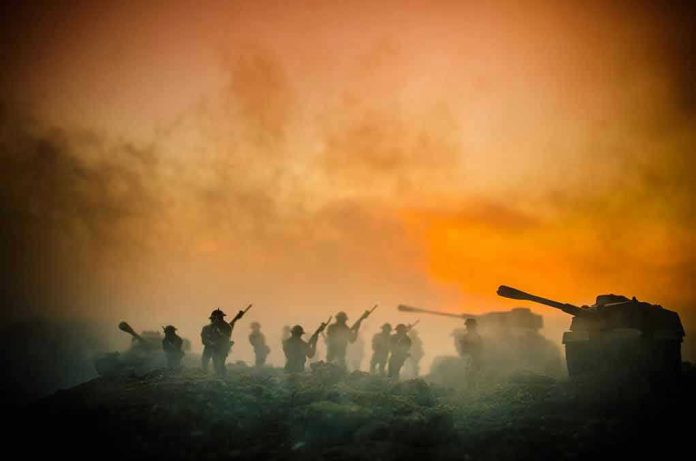
IDF’s mobilization of 60,000 reservists for a six-month occupation campaign in Gaza City signals a dramatic escalation that could reshape the region and test global patience with unchecked military force.
Story Snapshot
- Israel initiates its largest reservist call-up since 2023, aiming to occupy and control Gaza City, the last Hamas stronghold.
- Operation “Gideon’s Chariots II” marks a shift from targeted strikes to prolonged military occupation, with an expected six-month timeline.
- UN and major agencies report widespread destruction, severe civilian casualties, and a deepening humanitarian crisis in Gaza.
- International criticism grows over the operation’s proportionality and legality, as displaced populations face escalating hardship.
Unprecedented Military Mobilization and Strategic Objectives
The Israel Defense Forces have initiated the call-up of approximately 60,000 reservists as part of a coordinated assault on Gaza City, targeting what is described as Hamas’s final urban stronghold. Announced on August 20, 2025, and supported by Israel’s Defense Minister, this operation, codenamed “Gideon’s Chariots II,” is the largest military mobilization since the 2023-2024 Gaza conflict. Unlike previous campaigns focused on targeted raids, the current strategy is to occupy and control the city, aiming to eliminate Hamas’s operational capacity in the region.
Military actions began with a substantial assault on the Zeitoun neighborhood on August 11, followed by systematic ground and air operations. The operation’s six-month timeline signals Israel’s intent to establish a sustained military presence, fundamentally altering the existing balance of power. This scale of mobilization and the explicit goal of occupation sets a new precedent in the decades-long conflict, highlighting a determination for complete territorial and political control over Gaza City.
Humanitarian Fallout: Civilian Crisis and Infrastructure Destruction
The humanitarian impact of this military escalation has been immediate and severe. UN agencies report extensive destruction of residential neighborhoods, with at least 54 strikes on homes and shelters between August 8 and August 20. Civilian casualties are mounting amid mass displacement, as families are forced to flee repeated bombardments and ground incursions. Food insecurity, lack of medical care, and the destruction of critical infrastructure such as hospitals and schools have intensified the crisis, leaving Gaza’s population with dwindling options for safety and survival. Humanitarian organizations warn that the situation is rapidly deteriorating, with urgent relief efforts often hampered by ongoing hostilities.
The operation’s impact extends far beyond the battlefield. The deliberate targeting and occupation of densely populated urban areas have led to accusations of disproportionate use of force and violations of international law. International observers, including the United Nations, have condemned the “systematic destruction” of Gaza’s urban landscape and raised concerns about the legality and morality of the operation. These developments have triggered renewed debate over the responsibilities of military powers to safeguard civilian lives and infrastructure during conflict, as well as the long-term consequences for regional stability.
Stakeholder Dynamics and International Response
Key decision-makers—led by the Israeli government, military leadership, and Defense Minister Israel Katz—justify the operation as a necessary response to security threats posed by Hamas. Hamas, meanwhile, continues guerrilla resistance within the city, leveraging the urban environment to offset Israel’s conventional military superiority. Palestinian civilians are trapped between these forces, bearing the brunt of the violence. Internationally, actors including the US, EU, and Arab states are navigating a delicate balance: supporting Israel’s right to self-defense while warning against humanitarian abuses and calling for immediate aid access. Humanitarian agencies and the UN are increasingly vocal, demanding ceasefires and accountability for civilian harm, though their influence on the ground remains limited.
Long-Term Implications and Critical Perspectives
The operation’s short-term effects include unprecedented levels of displacement, widespread trauma, and the collapse of Gaza’s urban economy. In the long term, the occupation of Gaza City risks fueling further instability, insurgency, and deepening animosity between Israelis and Palestinians. The prospect of a protracted military presence could undermine diplomatic efforts and set a precedent for future operations elsewhere. Analysts warn that, despite claims of enhanced security, occupation may breed new cycles of violence and international condemnation, complicating both regional politics and global humanitarian standards.
IDF Calls Up 60,000 Reservists for 6-Month Assault on Gaza City https://t.co/Er5hImDA6E via @BreitbartNews
— 🇺🇸 The Briefing Room 🇺🇸 🇮🇱 (@Briefing__Room) August 20, 2025
Expert commentary underscores the dangers of urban warfare and the difficulty of achieving lasting peace through force. The scale and intensity of Israel’s current campaign raise fundamental questions about proportionality, civilian protection, and the future of conflict resolution in the Middle East. As the international community grapples with these developments, the enduring challenge will be to reconcile legitimate security concerns with the urgent imperative to uphold humanitarian principles and constitutional rights.
Sources:
Israel calls up thousands of reservists for invasion, occupation of Gaza City
UN News: Gaza City faces catastrophic destruction as IDF launches major assault
Israeli army launches new stage of offensive to occupy Gaza City









